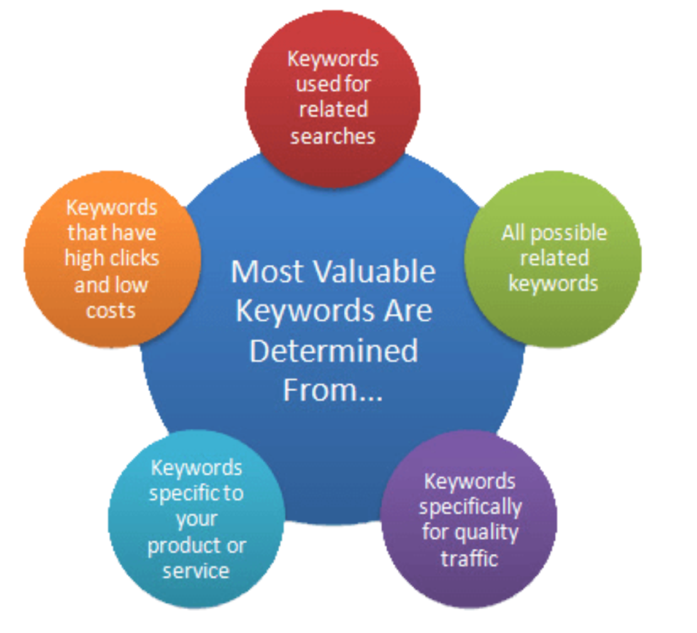Developing a solid keyword strategy is one of the best things you can do to help your business grow online. Keywords are essentially the foundation of SEO, and they can make or break your marketing plan. Many people are intimidated by the thought of doing their own keyword research, but coming up with a successful keyword strategy doesn’t have to be complicated; it just needs to be thorough. If you do your research and learn how keywords work and how to select and tailor them for your business, you’ll have a heads-up on your competition without having to hire an SEO team and shell out a large chunk of your marketing budget.
What is a keyword?
A keyword is a word or phrase that a person types into a search engine in order to locate information. For example, someone wanting to order pizza for dinner might type in a keyword phrase like “pizza near me” or “pizza coupons”. The resulting links that appear will be a direct result of what keywords were entered, ie: which sites have targeted these specific keywords.
There are two main types of keywords: short-tail keywords that are made up of one or two words, like “pizza” or “pizza restaurants”, and long-tail keywords that consist of 3 or more words like “pizza near me” or “pizza places open late”. Which ones you choose to include in your campaigns will impact your SEO, and there are strategies to determine which type you should target.
To Begin…
Before you start to worry about short vs long keywords, however, you need to come up with a basic list of potential keywords. You can do this by thinking about the goals you have for your website. When people land on your site, what do you want them to do? Do you want them to hire you for a service? Buy a product? Read your blog? The keywords you choose should directly reflect these goals. You should have a mix of both short and long- tail keywords. Short- tail keywords are harder to rank for, but they’re better for your long-term SEO strategy. Mixing them in with some long-tail keywords will help you improve your SEO right now while you’re working on ranking for the shorter terms.
image 1
Use Google Keyword Planner
Once you have a list of words you think you want to target, plug them in to Google Keyword Planner. It’s a free tool and one of the best ones out there, in my opinion. You get 2 options “Find New Keywords” and “Get search volume and forecasts”. For the sake of beginning a keyword strategy, I advise you choose “get new keywords”. Type in one from your list, and a list of hundreds (if not thousands) of related keywords will appear below. You can use this list to tailor your own list of keywords. The most important columns to look at are the “average monthly searches” and the “competition” columns. You want to choose keywords that have a high volume of searches (think 10k-1mil) but medium to low competition. That means that a lot of people are searching for these terms, but there aren’t a lot of websites targeting them. Thus, if you begin to target them on your site you should see a rise in your rankings. While it may be tempting to choose some obscure keywords because they’re easy to rank for, remember that if they’re not relevant to your business they won’t help you gain and KEEP new traffic. For more information on how to use Google Keyword Planner, click here.
image 2
How many keywords should I target?
One of the questions I get asked the most is “how many keywords should I have?” And there really isn’t a right answer to this. The more keywords you target, the more content you’ll need to produce and the longer it will most likely take to rank for these words. I usually suggest starting with 3 to 5 solid keywords and then going up from there after you start to see results. You definitely want to reevaluate your keywords every so often…once every quarter is usually a good benchmark. As you begin to rank for your first set of keywords you can start to add in more and more. SEO is a continually changing field, so you’ll need to constantly revisit your strategy and see what’s working well and what isn’t.
Now that I have some keywords, what do I do with them?
So now that you have a list of keywords, what should you do with them? The short answer is, design your website around them. This is part of having an optimized website. You want to incorporate them into the text of all your pages, as well as into your images and especially into your content. But beware of keyword stuffing- Google is smart and knows if you’re just adding in keywords to try to improve your SEO, and they’ll penalize you for it. You should only place keywords where they’re relevant and seem authentic.
The Takeaway
Keyword research should be an important part of any company’s marketing strategy, and while it can seem complex and overwhelming, it doesn’t have to be. By doing your research you’re already ahead of all the other business owners who either don’t bother with keywords or who just pay an agency to do it for them without truly understanding the purpose behind keywords and SEO. There are tons of guides that explain more in depth how to create and monitor a keyword strategy, and just as many tools (free and paid) that can accomplish the same purpose. Just stay true to your goals and don’t forget to monitor your progress so you can make adjustments as necessary.
Image 1: w3era.com
Image 2: ads.google.com



